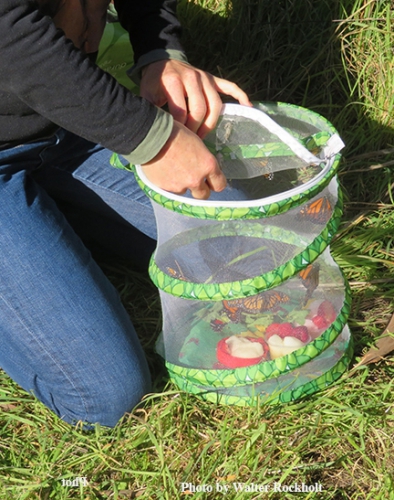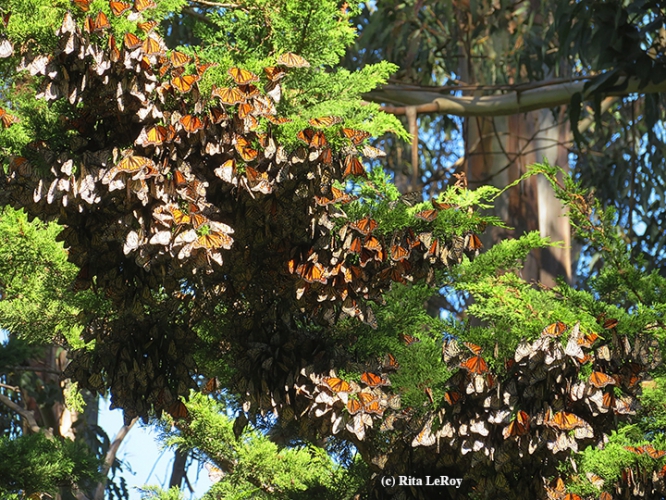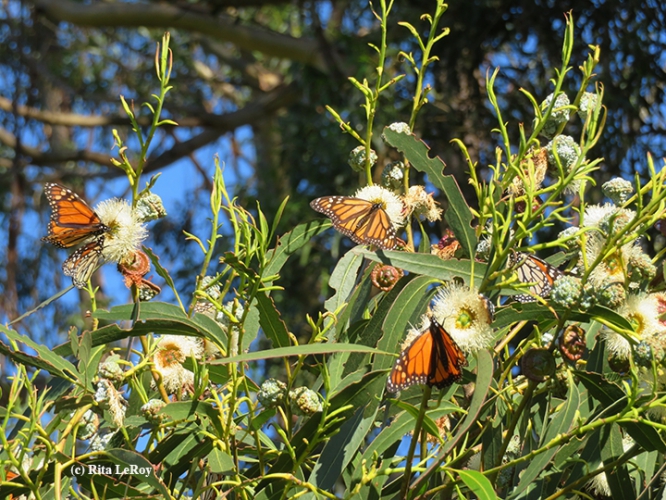From the Open-Publishing Calendar
From the Open-Publishing Newswire
Indybay Feature
Good Samaritans Relocate Monarch Butterflies to Sunny Santa Cruz
This is a story about how eight monarch butterflies escaped the freezing temperatures of Vacaville, Calif., and hitchhiked to sunny Santa Cruz, thanks to Good Samaritans (Good Monarcharians?) Rita LeRoy and Walter Rockholt of Vallejo. Photo: Rita LeRoy releases newly eclosed monarch butterflies in Santa Cruz. (Photo by Walter Rockholt)
It all started in mid-to-late November when 12 caterpillars surfaced in our pollinator garden in Vacaville. What! What are you doing here? Didn't you get the memo?
We'd just reared and released 54 monarchs. We'd just winterized the garden, pruning back the plants except for one flowering tropical milkweed. We'd leave that for the pollinators, and then, it, too, would freeze.
Freeze?
Well, so would the 12 monarch caterpillars.
Twelve! A dozen hungry, hunkered-down striped ‘cats. Talk about challenges! Too cold, too rainy, too little food and too many predators to survive.
Without a second thought, we brought them inside, tucked them into two zippered, meshed butterfly habitats (from the Bohart Museum of Entomology, UC Davis) and fed them milkweed. There they munched away, at times appearing to “sway” to soft classical music or “shake” to the harsh political news on National Public Radio. Friends and relatives came and went, glancing quizzically at us and the 'cats. “What are you going to do with them?”
It brought to mind the Starfish Story (adapted from Loren C. Eisley's “The Star Thrower”):
A young girl was walking along a beach upon which thousands of starfish had been washed up during a terrible storm. When she came to each starfish, she would pick it up, and throw it back into the ocean. People watched her with amusement.
“She had been doing this for some time when a man approached her and said, “Little girl, why are you doing this? Look at this beach! You can't save all these starfish. You can't begin to make a difference!”
The girl seemed crushed, suddenly deflated. But after a few moments, she bent down, picked up another starfish, and hurled it as far as she could into the ocean. Then she looked up at the man and replied, “Well, I made a difference to that one!”
The old man looked at the girl inquisitively and thought about what she had done and said. Inspired, he joined the little girl in throwing starfish back into the sea. Soon others joined, and all the starfish were saved.
Could these monarchs be starfish?
It was the holiday season and it was beginning to look a lot like chrysalids. The ‘cats, all 12 of them, each formed a “J.” Then came the chrysalids, those gorgeous gold-studded jadelike jewels--Mother Nature's magic, Father Time's gift, and humanity's treasure. The chrysalids held their own, in belligerent testimony to the monarch butterflies that didn't get the memo: “Reproduction is over!”
Eight Danaus plexippus eclosed or “hatched” in mid-December. We marveled as each new butterfly clutched its transparent pupal case, pumped its wings and prepared for flight. Of the last three, one eclosed on Christmas Eve, one on Christmas Day, and one on Tuesday, Dec. 27.
Despite the severity of the season outside, the monarchs thrived on the care and warmth inside. They fluttered around, dined on raspberries, orange juice and sugar-water, and roosted on the sides and ceiling of the butterfly habitat while National Public Radio “entertained” them.
What to do? Consider them “starfish” and drive “The Monarch Eight” to an overwintering spot along coastal California? (We'd just been to Santa Cruz, a 226-mile round trip, on Nov. 14.) Release them in Vacaville on a wing and a prayer? Or transport them to the Bohart Museum for “bed and breakfast” and public observation?
A friend who's an educator, a naturalist, a photographer, and an insect and gardening enthusiast came up with the ahh-so-perfect plan. Rita LeRoy, the 26-year “farm keeper” at the Vallejo City Unified School District's Loma Vista Farm, (a 5-acre outdoor classroom that provides hands-on educational activities involving plants and animals for children of all ages and abilities), told us of her pending trip to the monarch overwintering sites in Santa Cruz and said she'd be delighted to take them there.
So off the Vacaville-bred and reared monarchs went on Wednesday morning, Dec. 28 with the Good Monarcharians from Vallejo. Unlike Rita and Walter, however, the monarchs didn't know where they were going. One minute they're listening to NPR on a kitchen counter in Vacaville, and the next thing they know, an hour-and-a-half later, they're joining their buddies in Santa Cruz. Whoa! How did that happen? How'd we migrate that fast?
Rita LeRoy, known as "Farmer Rita" at Loma Vista Farm, released them, one by one, starting at 1 p.m. at the Lighthouse Field State Park. Flight! Freedom! Friends! One monarch lingered on her finger--probably the one that had eclosed the day before. The others did not linger. “The rest flew away to meet their new friends,” she related.
The overwintering site proved breathtaking, with the sun showcasing the hundreds of the iconic orange, black and white butterflies dancing in the warm breeze. “There were so many butterflies,” she marveled. “It was amazing.”
What a happy ending to a story about a small-scale conservation project that began in Vacaville and took flight in Santa Cruz. First we humans gave them roots; then we gave them wings.
Now this story has legs. “I enjoy learning about the interconnections in nature so I can share this information with the students,” said Rita-the-teacher (and a 25-year 4-H leader). “Monarchs are excellent example of the interconnection between plants and animals and the need for people to assist with the conservation of this beautiful creature.”
Yes, monarchs can be starfish, too.
We'd just reared and released 54 monarchs. We'd just winterized the garden, pruning back the plants except for one flowering tropical milkweed. We'd leave that for the pollinators, and then, it, too, would freeze.
Freeze?
Well, so would the 12 monarch caterpillars.
Twelve! A dozen hungry, hunkered-down striped ‘cats. Talk about challenges! Too cold, too rainy, too little food and too many predators to survive.
Without a second thought, we brought them inside, tucked them into two zippered, meshed butterfly habitats (from the Bohart Museum of Entomology, UC Davis) and fed them milkweed. There they munched away, at times appearing to “sway” to soft classical music or “shake” to the harsh political news on National Public Radio. Friends and relatives came and went, glancing quizzically at us and the 'cats. “What are you going to do with them?”
It brought to mind the Starfish Story (adapted from Loren C. Eisley's “The Star Thrower”):
A young girl was walking along a beach upon which thousands of starfish had been washed up during a terrible storm. When she came to each starfish, she would pick it up, and throw it back into the ocean. People watched her with amusement.
“She had been doing this for some time when a man approached her and said, “Little girl, why are you doing this? Look at this beach! You can't save all these starfish. You can't begin to make a difference!”
The girl seemed crushed, suddenly deflated. But after a few moments, she bent down, picked up another starfish, and hurled it as far as she could into the ocean. Then she looked up at the man and replied, “Well, I made a difference to that one!”
The old man looked at the girl inquisitively and thought about what she had done and said. Inspired, he joined the little girl in throwing starfish back into the sea. Soon others joined, and all the starfish were saved.
Could these monarchs be starfish?
It was the holiday season and it was beginning to look a lot like chrysalids. The ‘cats, all 12 of them, each formed a “J.” Then came the chrysalids, those gorgeous gold-studded jadelike jewels--Mother Nature's magic, Father Time's gift, and humanity's treasure. The chrysalids held their own, in belligerent testimony to the monarch butterflies that didn't get the memo: “Reproduction is over!”
Eight Danaus plexippus eclosed or “hatched” in mid-December. We marveled as each new butterfly clutched its transparent pupal case, pumped its wings and prepared for flight. Of the last three, one eclosed on Christmas Eve, one on Christmas Day, and one on Tuesday, Dec. 27.
Despite the severity of the season outside, the monarchs thrived on the care and warmth inside. They fluttered around, dined on raspberries, orange juice and sugar-water, and roosted on the sides and ceiling of the butterfly habitat while National Public Radio “entertained” them.
What to do? Consider them “starfish” and drive “The Monarch Eight” to an overwintering spot along coastal California? (We'd just been to Santa Cruz, a 226-mile round trip, on Nov. 14.) Release them in Vacaville on a wing and a prayer? Or transport them to the Bohart Museum for “bed and breakfast” and public observation?
A friend who's an educator, a naturalist, a photographer, and an insect and gardening enthusiast came up with the ahh-so-perfect plan. Rita LeRoy, the 26-year “farm keeper” at the Vallejo City Unified School District's Loma Vista Farm, (a 5-acre outdoor classroom that provides hands-on educational activities involving plants and animals for children of all ages and abilities), told us of her pending trip to the monarch overwintering sites in Santa Cruz and said she'd be delighted to take them there.
So off the Vacaville-bred and reared monarchs went on Wednesday morning, Dec. 28 with the Good Monarcharians from Vallejo. Unlike Rita and Walter, however, the monarchs didn't know where they were going. One minute they're listening to NPR on a kitchen counter in Vacaville, and the next thing they know, an hour-and-a-half later, they're joining their buddies in Santa Cruz. Whoa! How did that happen? How'd we migrate that fast?
Rita LeRoy, known as "Farmer Rita" at Loma Vista Farm, released them, one by one, starting at 1 p.m. at the Lighthouse Field State Park. Flight! Freedom! Friends! One monarch lingered on her finger--probably the one that had eclosed the day before. The others did not linger. “The rest flew away to meet their new friends,” she related.
The overwintering site proved breathtaking, with the sun showcasing the hundreds of the iconic orange, black and white butterflies dancing in the warm breeze. “There were so many butterflies,” she marveled. “It was amazing.”
What a happy ending to a story about a small-scale conservation project that began in Vacaville and took flight in Santa Cruz. First we humans gave them roots; then we gave them wings.
Now this story has legs. “I enjoy learning about the interconnections in nature so I can share this information with the students,” said Rita-the-teacher (and a 25-year 4-H leader). “Monarchs are excellent example of the interconnection between plants and animals and the need for people to assist with the conservation of this beautiful creature.”
Yes, monarchs can be starfish, too.
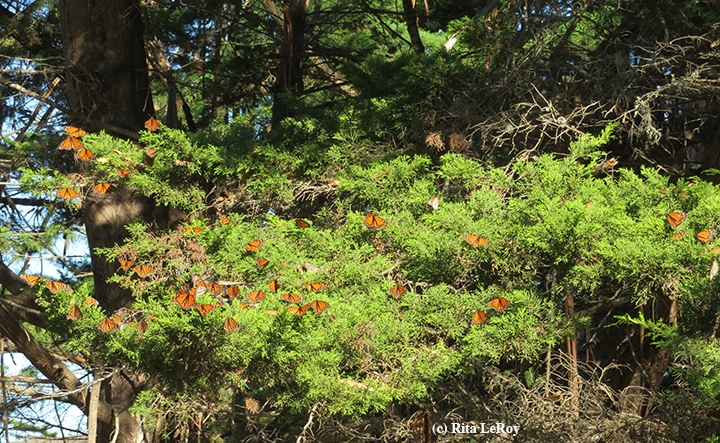
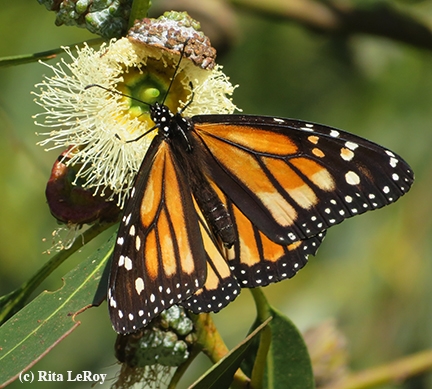
Add Your Comments
We are 100% volunteer and depend on your participation to sustain our efforts!
Get Involved
If you'd like to help with maintaining or developing the website, contact us.
Publish
Publish your stories and upcoming events on Indybay.
Topics
More
Search Indybay's Archives
Advanced Search
►
▼
IMC Network



